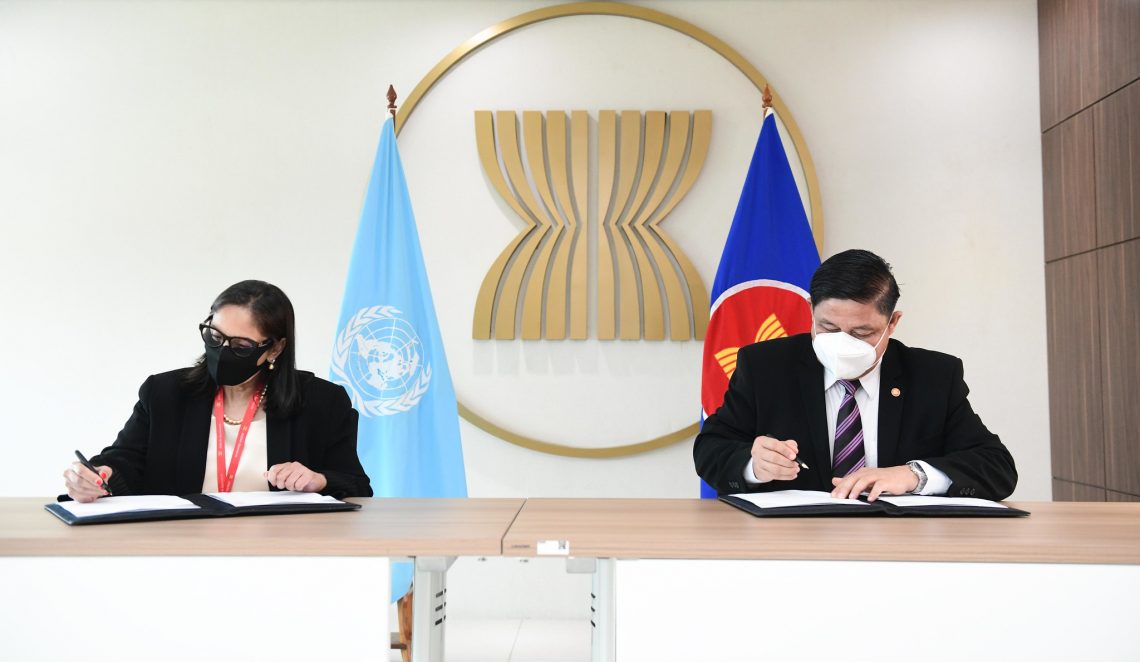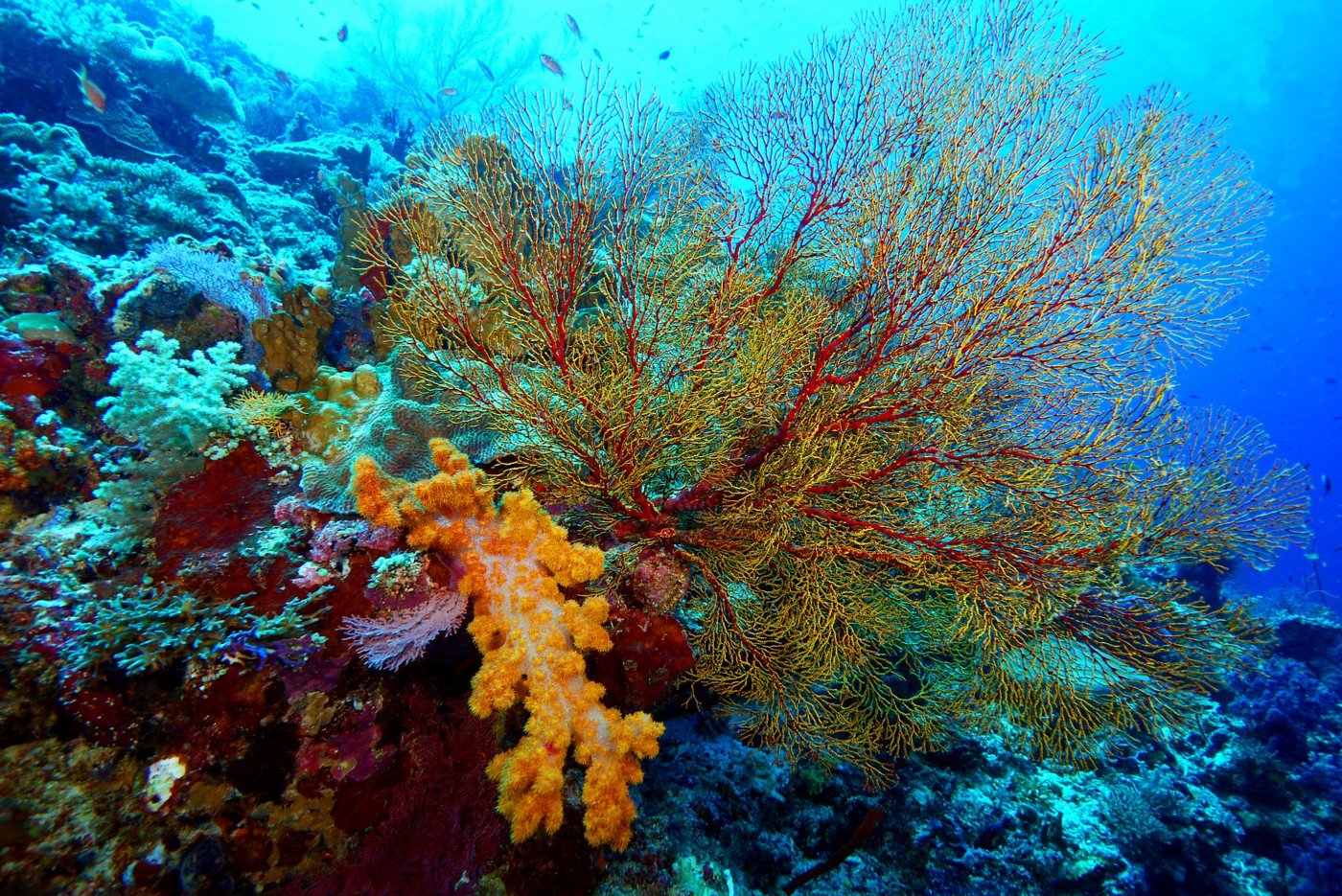Joint Media Release: ASEAN and UNOPS sign Agreement to Combat Marine Plastic Pollution in Southeast Asia

 |
ASEAN has the most extensive and diverse coral reefs in the world, which account for more than 28 per cent (almost 70,000 square kilometres) of the global total, and largely consist of fringing reefs. The annual estimated value of ecosystem services from coral reefs comes to US$ 112.5 billion, while mangroves alone account for US$ 5.1 billion. Marine fishery production in the region is an important component of the economies of coastal ASEAN Member States, with Indonesia leading production, followed by Viet Nam, Myanmar, and the Philippines.
Unfortunately, these resources are under threat from multiple factors, including overfishing, destructive fishing practices, pollution from human activities (i.e. marine debris and oil spill), land-use change, and climate change. These factors have negative impacts on coastal and marine resources which are an important food supply, act as functional buffer zones for natural weather disturbances, maintain water cycles, and serve as livelihoods for many communities in the ASEAN region.
Except for landlocked Lao PDR, all ASEAN Member States are facing a number of challenges in managing and protecting its extensive coastal and marine environments. The main challenges are (i) degradation of coastal habitats, (ii) reduction in ecosystem integrity and biodiversity loss, (iii) increasing coastal and marine pollution from nutrients, eutrophication and marine debris (e.g. plastic waste), (iv) illegal desludging and disposal of tanker sludge at sea and oil spill, (v) increasing impacts of climate change and (vi) poor management and governance.
Several commercially important species (i.e. Tuna, Scads and Mackerels) caught in the region are in danger of being decimated through overfishing, leading to the degradation of the region’s coastal and marine biodiversity and threatening food security. The problem of marine debris pollution has recently gained attention worldwide, specifically in the ASEAN region, where reports of floating islands of garbage sighted at sea recently made headlines. With a temperature increase of 0.14°C to 0.20°C per decade since the 1960s, climate change will have deep impacts on the productivity of coasts and oceans, as well as affect the wellbeing of coastal inhabitants. Some countries in ASEAN have formulated regulatory measures related to coastal and marine resources management, such as the issuance of permits for fishing, logging, and mangrove harvesting. However, most of these measures have not proven effective, largely due to enforcement failure and lack of support for the communities concerned.
Recognising the importance of coastal and marine resources for the livelihoods of ASEAN people as well as socio-economic development in the ASEAN region, it is important for ASEAN Member States to discuss, coordinate and overcome above key challenges on coastal and marine environment to ensure ASEAN’s coastal and marine environment are sustainably managed, representative ecosystems, pristine areas and species are protected, and economic activities are sustainably managed.
At the global level, ASEAN Member States have committed to support the full implementation of the Strategic Plan for Biodiversity 2011–2020 and the Aichi Biodiversity Targets of the Convention on Biological Diversity (CBD), as well as contribute to the United Nations Sustainable Development Goals, particularly Goal 14 (Life Below Water) which promotes the conservation and sustainable use of the oceans, seas and marine resources for sustainable development. It is important for ASEAN to focus on these issues in order to achieve targets in the ASCC Blueprint 2025, particularly on conservation and sustainable management of biodiversity and natural resources.
ASPEN also provides a forward-looking plan for the next 10 years to promote concerted actions through cooperation and collaboration across ASEAN Member States for addressing key challenges on managing and protecting coastal and marine environments. Efforts under this Strategic priority will focus on seven programmatic areas: (i) key coastal and marine area conservation, (ii) endangered coastal and marine species conservation, (iii) tanker desludging and oil spill reduction, (iv) coastal and marine pollution mitigation, (v) aquatic invasive alien species (vi) climate change issues and impacts in coastal areas, and (vii) integrated coastal management and marine spatial planning.
To help protect shared marine waters in the region, ASEAN adopted the following programmes:
The ASEAN Marine Water Quality Criteria (AMWQC) and Criteria for Marine Heritage Areas in 2002. Seventeen parameters were unanimously agreed and adopted by ASEAN on common marine water quality for the protection of the coastal and marine environment and human health.
The ASEAN Marine Water Quality Criteria: Management Guidelines and Monitoring Manual in 2008.
The ASEAN Mechanism to Enhance Surveillance against Desludging and Disposal of Tanker Sludge at Sea was also adopted by ASEAN Environment Ministers during the 11th ASEAN Ministerial Meeting on the Environment (AMME) in 2009. The objective of the Mechanism is to ensure coordinated efforts among ASEAN Member States in controlling tanker desludging activities and in promoting proper disposal of the tanker sludge at approved disposal facilities.
A publication on Marine Protected Areas in Southeast Asia was produced by ASEAN Centre for Biodiversity (ACB) to provide a reference for policymakers, planners, academia, and park managers on the management of marine protected areas to save, rehabilitate and safeguard the coastal and marine resources in the region. With support from ACB, AWGCME has also undertaken the development of both offline and online interfaces for encoding of Species and Protected Areas. The offline and online database is expected to facilitate information sharing among the ASEAN Member States.
Implementation of the ASEAN-Korea Environmental Cooperation Project (AKECOP) Phase VI with support from the ASEAN-ROK Special Cooperation Fund, titled Restoration of Degraded Terrestrial and Mangrove Ecosystems and Conservation of Biodiversity in the ASEAN Region, continues to enhance the capacity of ASEAN Member States in managing their forest and mangrove ecosystems by providing low carbon green livelihoods for the people, while rehabilitating degraded areas and maintaining wood biomass to contribute to the mitigation of climate change in the region.
ASEAN-ROK Course on Oil Pollution Preparedness, Response and Cooperation for the First Responders (Level 1) was held on 14-18 March 2016 in Busan, Republic of Korea, with funding support from the ASEAN-ROK Special Cooperation Fund (SCF). The second training on the Scene Commanders/Supervisors (Level 2) on Oil Spill Response was held on 23-27 May 2016 in Busan, Republic of Korea.
Over the next 10 years, the main objectives of the AWGCME Action Plan are:
To ensure ASEAN’s coastal and marine environment are sustainably managed; representative ecosystems, pristine areas and species are protected; economic activities are sustainably managed; and public awareness of the coastal and marine environment instilled;
To conserve clean and healthy coastal and marine environments for ASEAN’s sustainable development by reducing anthropogenic threats to coastal and marine ecosystems;
To enhance inter-agency and inter-sectoral coordination at the regional and international levels for achieving sustainable management of the coastal and marine environment and responding to transboundary issues through good management practices and strengthened policies.
ASEAN Working Group on Coastal and Marine Environment (AWGCME) will be the main responsible body for the implementation of the programmes and activities of this Strategic Priority Area, in coordination with ASEAN Centre for Biodiversity (ACB) and ASEAN Working Group on Nature Conservation and Biodiversity (AWGNCB), as well as other working groups and sectoral bodies and/or partners (working in e.g. agriculture, transportation, marine science and technology), whenever relevant.
The AWGCME will oversee the planning, technical and implementation issues under this Strategic Priority Area, while the ASEAN Environment Ministers and the ASEAN Senior Officials on Environment will provide policy and strategic guidance for its work. Lead countries of each programme/activity under the strategic priority are expected to develop proposal of detailed implementation workplan, implement the activity in coordination with AMS and ASEC, and provide regular progress updates to AWGCME.
The activities under this Strategic Priority could be implemented through partnerships and regional collaborations with organisations working on coastal and marine management. Potential partners or platforms include UN Environment-Coordinating Body on the Seas of East Asia (COBSEA), Partnerships in Environmental Management for the Seas of East Asia (PEMSEA), Coral Triangle Initiative-Coral Reefs, Fisheries and Food Security (CTI-CFF), Southeast Asian Fisheries Development Center (SEAFDEC), International Union for Conservation of Nature (IUCN), Ramsar Convention, and United Nations Educational, Scientific and Cultural Organisation (UNESCO).
Activities could also be implemented through cooperation and support from ASEAN Dialogue / Development Partners, for example, ASEAN Plus Three Countries (China, Japan and ROK), and the European Union (EU). Other organisations working on marine science, conservation, and capacity building of communities in the regions, Local Government Units and private sector actors, could be invited to participate in relevant consultation or knowledge sharing workshops or support the activities of the AWGCME.
Credits: Tubbataha Reefs Natural Park (Philippines) - ASEAN Centre for Biodiversity